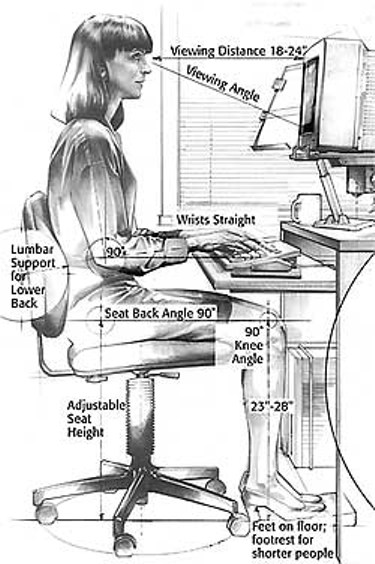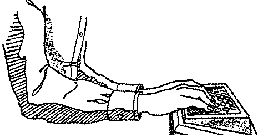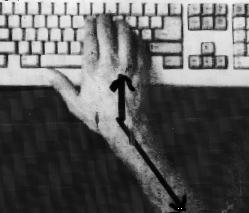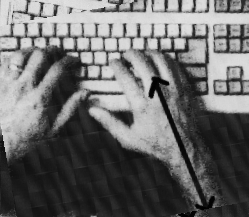As more and more work, education and recreation involves computers, everyone needs to be aware of the hazard of Repetitive Strain Injury to the hands and arms resulting from the use of computer keyboards and mice. This can be a serious and very painful condition that is far easier to prevent than to cure once contracted, and can occur even in young physically fit individuals. It is not uncommon for people to have to leave computer-dependent careers as a result, or even to be disabled and unable to perform tasks such as driving or dressing themselves.
Repetitive Strain Injuries occur from repeated physical movements doing damage to tendons, nerves, muscles, and other soft body tissues. Occupations ranging from meatpackers to musicians have characteristic RSIs that can result from the typical tasks they perform. The rise of computer use and flat, light-touch keyboards that permit high speed typing have resulted in an epidemic of injuries of the hands, arms, and shoulders. Use of pointing devices like mice and trackballs are as much a cause, if not more so. The thousands of repeated keystrokes and long periods of clutching and dragging with mice slowly accumulates damage to the body : another name for the condition is Cumulative Trauma Disorder. This can happen even more quickly as a result of typing technique and body positions that place unnecessary stress on the tendons and nerves in the hand, wrist, arms, and even the shoulders and neck. Lack of adequate rest and breaks and using excessive force almost guarantee trouble.
Understanding and Preventing Computer-Related Repetitive Strain Injury (RSI)
With the increasing reliance on computers for work, education, and recreation, it’s essential to recognize the risks of Repetitive Strain Injury (RSI). RSI is a potentially severe and painful condition that affects the hands and arms due to prolonged use of keyboards and mice. It is easier to prevent than to cure and can impact individuals of all ages and fitness levels. Severe cases may force people to leave computer-dependent careers or limit their ability to perform daily tasks like driving or dressing.
What is RSI?
Repetitive Strain Injuries occur from repeated physical movements that damage tendons, nerves, muscles, and other soft tissues. Various professions, from musicians to meatpackers, have characteristic RSIs. The rise of computer usage, coupled with flat, light-touch keyboards that enable rapid typing, has led to an epidemic of hand, arm, and shoulder injuries. Pointing devices like mice and trackballs are equally, if not more, responsible for these injuries.
RSI develops gradually from thousands of repeated keystrokes or prolonged mouse usage. Improper typing techniques, poor posture, and insufficient breaks exacerbate the issue. The condition is also known as Cumulative Trauma Disorder.
What Are the Symptoms?
- Tightness, discomfort, stiffness, soreness, or burning in the hands, wrists, fingers, forearms, or elbows.
- Tingling, coldness, or numbness in the hands.
- Loss of strength or coordination in the hands.
- Pain that disrupts sleep.
- Frequent need to massage the hands, wrists, or arms.
- Upper back, shoulder, or neck pain related to computer usage.
How Can RSI Be Prevented?
1. Maintain Proper Typing Technique and Posture: Focus on correct positioning and work habits rather than relying solely on ergonomic gadgets. Use equipment that supports healthy posture.
2. Ensure Optimal Workstation Setup:


Proper posture involves keeping thighs and forearms level or slightly sloped, wrists straight, and the body relaxed. Avoid rigid postures and stretch frequently to reduce strain.
3. Avoid Resting Wrists While Typing: Your wrists should remain neutral, and your arms should move your hands. Use palm rests only during pauses.

4. Avoid Bending Wrists: Keep wrists straight to prevent stress.


5. Tilt Your Keyboard: Slightly tilt the back edge of your keyboard down for comfort, ensuring the entire setup remains ergonomically sound.
6. Increase Font Sizes: Larger fonts reduce eye strain and encourage a relaxed posture.
7. Use a Light Touch: Avoid pounding on keys.
8. Use Both Hands: For operations like Ctrl+C or Alt+F, use both hands to prevent unnecessary strain.
9. Take Frequent Breaks: Regular stretching and relaxation breaks are essential.
10. Handle the Mouse Gently: Avoid gripping the mouse tightly.
11. Keep Hands Warm: Warm hands reduce stiffness and improve circulation.
12. Minimize Unnecessary Computer Usage: Limit activities that contribute to RSI.
13. Consider Voice Recognition Software: This reduces the need for typing and mouse usage.
14. Avoid Shoulder and Neck Strain: Do not tuck the phone between your ear and shoulder while typing.
15. Address Eye Strain: Set up your computer to reduce strain on your eyes.
16. Listen to Your Body: Stop typing if it causes pain, and consult a medical professional if the pain persists.
17. Evaluate Other Activities: Other activities, like sports or hobbies, may contribute to RSI and should be assessed.




